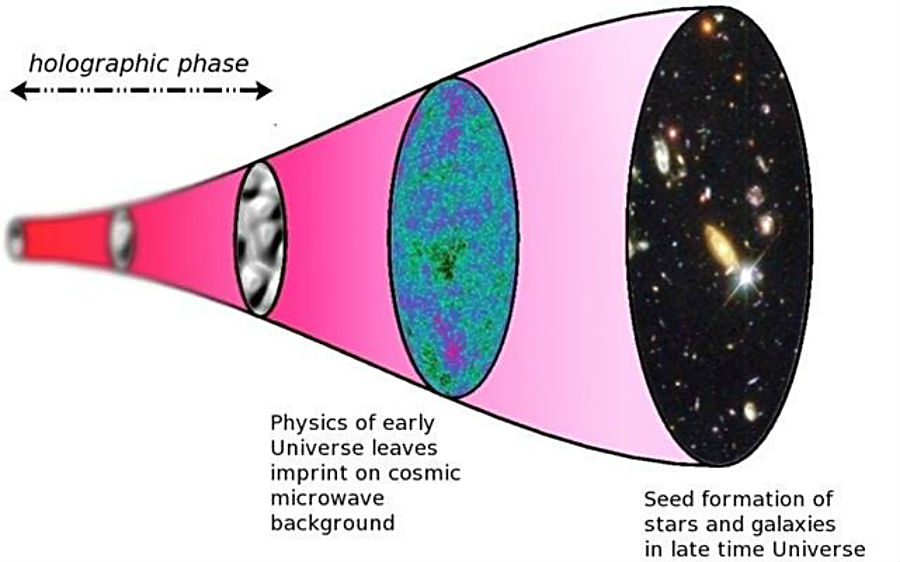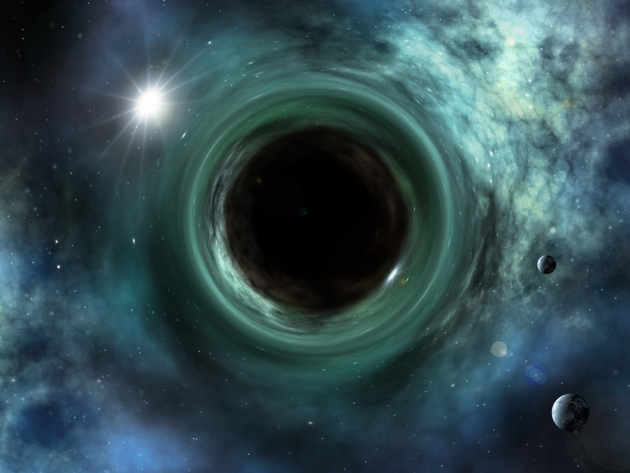Groundbreaking: First observational evidence that our Universe is a hologram
Groundbreaking: First observational evidence that our Universe is a hologram
By
According to a new study, the universe we live in may be a ‘vast and complex hologram’. Furthermore, our perception of life in 3D may only by an illusion. For the first time ever, a team of physicists has provided some of the clearest evidence yet that our Universe could be just one big ‘hologram’.
The existence of a ‘holographic universe’ was first proposed in the 1990’s and indicates that all information, which makes up our 3D ‘reality’ is in fact contained in a 2D surface on its boundaries.
While the idea of a holographic universe has existed for decades until NOW, this bizarre theory has never been tested.
However, recent mathematical models seem to suggest that the revolutionary and controversial principle could be true.
The researchers of the study came to this conclusion after investigating the irregularities that were found the be present in the ‘afterglow’ of the Big Bang.
Researchers suggest that they have found substantial evidence which supports the existence of a holographic universe. This finding will transform our knowledge of the entire universe they add.
Scientist from the university of Southampton, together with colleagues at the University of Waterloo (Canada); of the Perimeter Institute (Canada); of the INFN, of Lecce (Italy); and the University of Salento (Italy), believe there is as much evidence for this theory as for traditional explanations for these irregularities. Their study has been published the journal Physical Review Letters.
Speaking about the discovery, Professor Kostas Skenderis, of mathematical sciences at the University of Southampton, said:
“Imagine that everything you see, feel and hear in three dimensions (and your perception of time) in fact emanates from a flat two-dimensional field. The idea is similar to that of ordinary holograms where a three-dimensional image is encoded in a two-dimensional surface, such as in the hologram on a credit card.”
“However, this time, the entire universe is encoded.”
Researchers say that their theory can be compared to watching a movie in 3D.
Even though the movie itself is not a ‘hologram’, as the pictures we see have height, width, and depth, it all originates from a FLAT 2D screen.
Scientists say there is one crucial difference: in our 3D universe, we can touch objects and the ‘projection’ is ‘real’ from our perspective, he said.
As explained by ScienceAlert, the entire idea is that the volume of space is ‘encoded’ on a boundary – or an observer-dependent gravitational horizon – which means it requires one less dimension than it appears.
“Imagine that everything you see, feel, and hear in three dimensions (and your perception of time) in fact emanates from a flat two-dimensional field,” says one of the team, Kostas Skenderis from the University of Southampton in the UK.
“The idea is similar to that of ordinary holograms, where a three-dimensional image is encoded in a two-dimensional surface, such as in the hologram on a credit card. However, this time, the entire Universe is encoded.”

I’m confused, are we living in a hologram?
Not quite. In fact, researchers say they’re far from proving that our early Universe was actually a holographic projection, but the fact that observational evidence from the real world could explain missing parts of the laws of physics in two dimensions means we can’t reasonably rule it out.
Niayesh Afshordi explains that their model does not prove that we are all living in a hologram since their model applies to the universe at its VERY early stages.
The question of how things transitioned from two dimensions to three is now anyone’s guess.
“I would say you don’t live in a hologram, but you could have come out of a hologram,” Afshordi told Gizmodo. “[In 2017], there are definitely three dimensions.”
Reference:
***
Simulations back up theory that Universe is a hologram
A ten-dimensional theory of gravity makes the same predictions as standard quantum physics in fewer dimensions.
Article tools
A team of physicists has provided some of the clearest evidence yet that our Universe could be just one big projection.

In 1997, theoretical physicist Juan Maldacena proposed1 that an audacious model of the Universe in which gravity arises from infinitesimally thin, vibrating strings could be reinterpreted in terms of well-established physics. The mathematically intricate world of strings, which exist in nine dimensions of space plus one of time, would be merely a hologram: the real action would play out in a simpler, flatter cosmos where there is no gravity.
Maldacena's idea thrilled physicists because it offered a way to put the popular but still unproven theory of strings on solid footing — and because it solved apparent inconsistencies between quantum physics and Einstein's theory of gravity. It provided physicists with a mathematical Rosetta stone, a 'duality', that allowed them to translate back and forth between the two languages, and solve problems in one model that seemed intractable in the other and vice versa (see 'Collaborative physics: String theory finds a bench mate'). But although the validity of Maldacena's ideas has pretty much been taken for granted ever since, a rigorous proof has been elusive.
In two papers posted on the arXiv repository, Yoshifumi Hyakutake of Ibaraki University in Japan and his colleagues now provide, if not an actual proof, at least compelling evidence that Maldacena’s conjecture is true.
In one paper2, Hyakutake computes the internal energy of a black hole, the position of its event horizon (the boundary between the black hole and the rest of the Universe), its entropy and other properties based on the predictions of string theory as well as the effects of so-called virtual particles that continuously pop into and out of existence (see 'Astrophysics: Fire in the Hole!'). In the other3, he and his collaborators calculate the internal energy of the corresponding lower-dimensional cosmos with no gravity. The two computer calculations match.
“It seems to be a correct computation,” says Maldacena, who is now at the Institute for Advanced Study in Princeton, New Jersey and who did not contribute to the team's work.
Regime change
The findings “are an interesting way to test many ideas in quantum gravity and string theory”, Maldacena adds. The two papers, he notes, are the culmination of a series of articles contributed by the Japanese team over the past few years. “The whole sequence of papers is very nice because it tests the dual [nature of the universes] in regimes where there are no analytic tests.”
“They have numerically confirmed, perhaps for the first time, something we were fairly sure had to be true, but was still a conjecture — namely that the thermodynamics of certain black holes can be reproduced from a lower-dimensional universe,” says Leonard Susskind, a theoretical physicist at Stanford University in California who was among the first theoreticians to explore the idea of holographic universes.
Neither of the model universes explored by the Japanese team resembles our own, Maldacena notes. The cosmos with a black hole has ten dimensions, with eight of them forming an eight-dimensional sphere. The lower-dimensional, gravity-free one has but a single dimension, and its menagerie of quantum particles resembles a group of idealized springs, or harmonic oscillators, attached to one another.
Nevertheless, says Maldacena, the numerical proof that these two seemingly disparate worlds are actually identical gives hope that the gravitational properties of our Universe can one day be explained by a simpler cosmos purely in terms of quantum theory.




Comments
Post a Comment